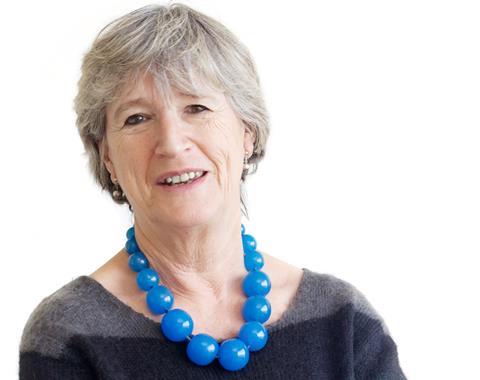Gillian Darley finds parallels between Anni Albers, Nicholas Grimshaw and Hawkins Brown’s Here East

The recent exhibition of Anni Albers’ work at Tate Modern was a revelation to me as to many. Her work was a lifelong programme of continual, fruitful, investigation and fresh thinking. She began as she meant to go on; a student at the Bauhaus, she used a new synthetic material, cellophane, wove it with chenille, and produced a remarkable auditorium wall covering, in which the interlaced threads were designed to reflect light, while the fabric was also satisfactorily soundproof.
At every turn of her long career as a weaver, she gave the conventions of textiles a new thrust and seemed able to draw out different properties and applications from almost anything she chose. Her work might be aesthetically effective, it usually was, but that was only one of her objectives.
Later on, considering the possibilities of fabric screens, she developed a theory and practice in what she termed “the pliable plane”. She envisaged fabric panels in museum displays, and within modernist rooms, the fluidity of fabric “walls” adding an indeterminant aspect to otherwise defined spaces, with materials which might equally be transparent or reflective. The longer you look at Albers’ work, the more subtly inventive it reveals itself to be.
With Albers’ work still fresh in my head, I found myself drawing parallels with aspects of Nick Grimshaw’s work, particularly the earliest job of all. In a film made to celebrate Grimshaw’s RIBA Gold Medal Award he talks about journeys made to Southampton around 1965 to visit caravan makers and boat builders in order to select the prefabricated GRP bathroom pods that he would set to spiral up a steel service tower, itself ingeniously clipped on to the back of a terrace in Paddington, converted into student accommodation.
Decades later, the honeycomb-patterned 2m-deep biomes of the Eden Project were made of triple-layered ETFE in order to keep the weight sufficiently low, the interior atmosphere sufficiently controlled, in this new featherweight natural world floating above the great pits of the abandoned china clay works. Enquiring minds, questing and testing well beyond the obvious, link Albers and Grimshaw, both energised by youth – though 40 years apart.
>> Also read: Technical Study: The Gantry, Here East, London
>> Also read: Anni Albers, the Bauhaus and the pliable plane
At Here East, north of the Queen Elizabeth Park, the entire project is novel, albeit in a recently redundant building. Hawkins Brown has reworked, and rebranded, the massive Olympic broadcasting complex, and there’s a sense of enormous energy building up indoors with the focus on research and robotics, the confluence between academe (UCL, the Bartlett in particular, and Loughborough University) and industry (Ford are also here).
And lest all this seem a touch inscrutable, the rear decks of the building, known as the Gantry, which had previously housed a plethora of equipment for the media centre, has now become a couple of little streets of worksheds, set up to be offices or studios.
From outside, the Trampery on the Gantry is a row of jazzy beach-huts, but all are constructed from the Wikihouse open source template, then clad every which way. Back indoors, three wacky meeting pods are suspended high in the atria.
Modelled by ES Global using advanced parametric 3D tools and fabricated on site, all three are dressed in multi-coloured panels, one in wood, another in metal, a third in fabric – to emphasise the roots of the industrial East End of London and embodying the collaborative ethos of the place.
Here East is not a grey and worthy reuse of a space big enough to park four jumbo jets but a sparky, jumping confluence of where we might (if the gods are kind) be heading. It could hardly be more welcome now.
















No comments yet